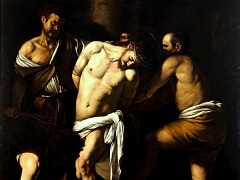Crucifixion of Saint Andrew, 1607 by Caravaggio

This painting, Crucifixion of Saint Andrew, previously known only through copies, the Cleveland picture recently emerged as the undoubted original of a work referred to by
Bellori. It was taken to Spain by the Spanish Viceroy of Naples, the conde de Benavente, when his seven-year term of office ended in July 1610, and installed in his family
palace at Valladolid where, in an inventory of 1653, it was valued at 1500 ducats, higher than any other picture in the collection. It was recently rediscovered in the Arnaiz
collection, Madrid, and acquired by the Cleveland Museum of Art in 1976. The iconography presents some problems and would appear not to represent the process of St. Andrew's attachment
to the cross. How, otherwise, can we account for the fact that he is, on the evidence of his face and his twisted fingers, on the verge of death, when we know from The Golden Legend
that he survived for two days on the cross, discoursing about Christianity with the crowd ? The answer suggested by Denis Marion and Mrs. Lurie is surely correct: that Caravaggio
has chosen a very rarely painted episode which is supposed to have occurred shortly before the saint's death on his cross. Having been subjected to Andrew's preaching for nearly two
days, the crowd was impressed by his teaching and clamoured for his release, which Aegeas, Proconsul of Patras, pictured in a plumed hat, fearfully agreed to, only to find that when
his men attempted to untie the body they were thwarted by a strange paralysis, the result of divine intervention in response to Andrew's plea that he should be allowed to die.
Another seeming incongruity is that St. Andrew is tied to a standard vertical cross rather than to the 'X'-shaped crux decussata usually associated with his name. This is
explicable by the fact that two important sixteenth-century writers, Joannes Molanus and Justus Lipsius, explicity asserted that the saint had, according to all the evidence,
in fact been executed on a Latin cross like Christ himself. It was only during the seventeenth century that the crux decussata became widely accepted as the type of
'St. Andrew's Cross'.
















